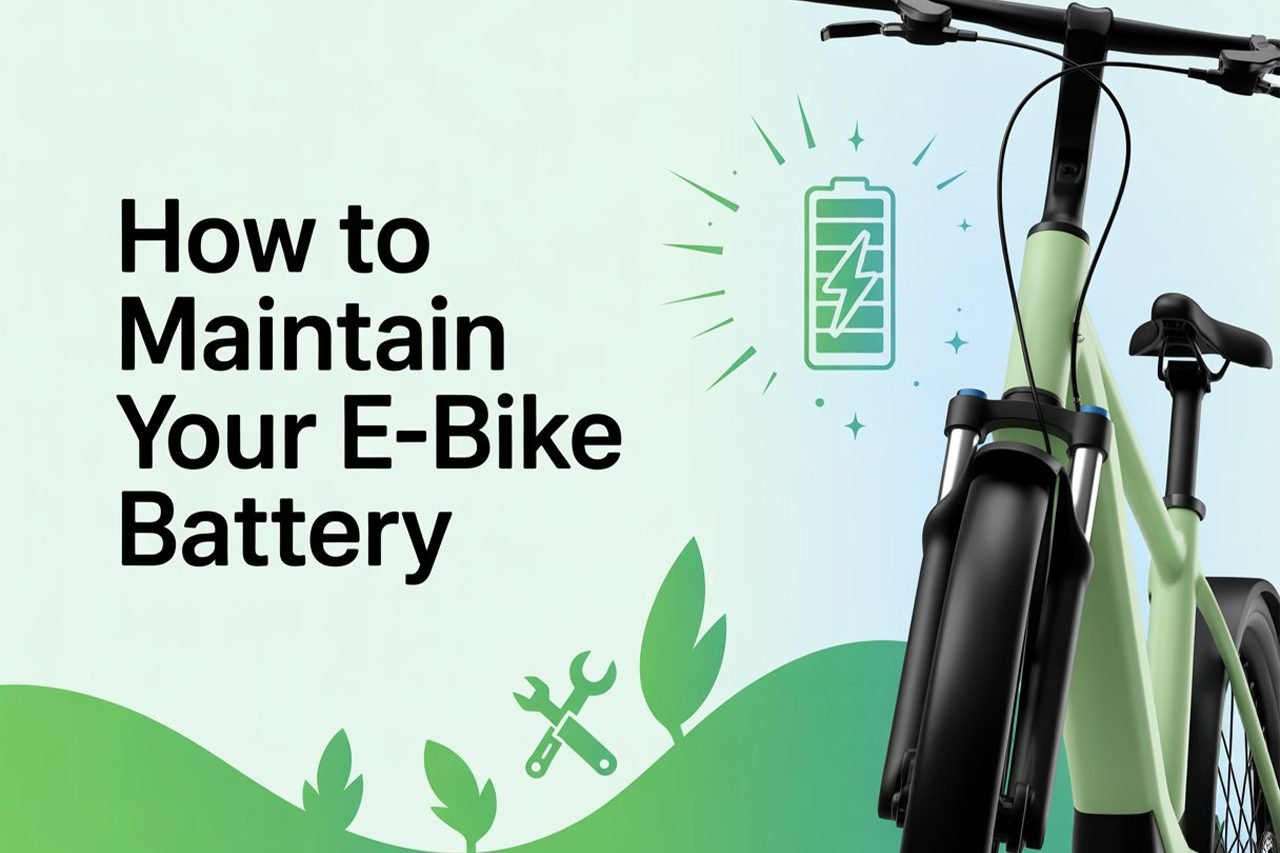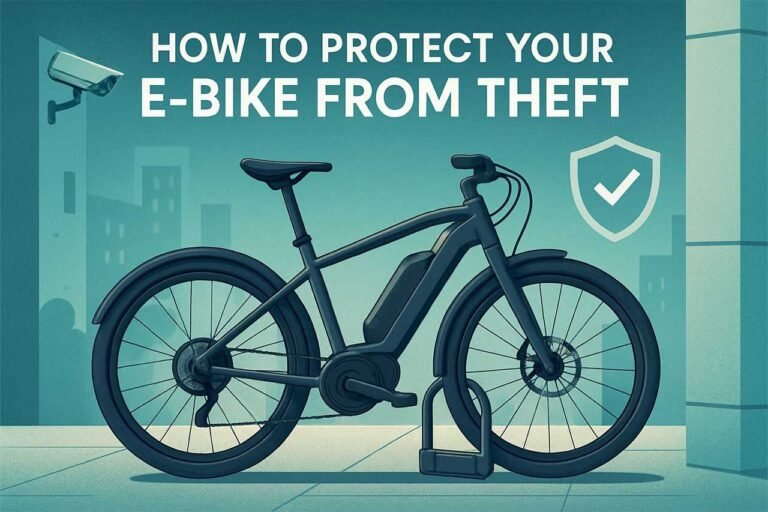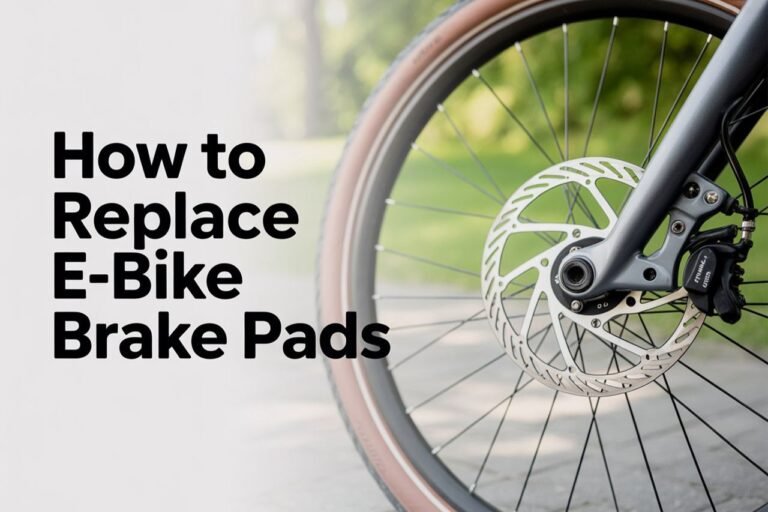
The e-bike revolution has changed how we commute, exercise, and explore our surroundings. With their efficient motors and advanced battery technology, electric bikes offer an eco-friendly and exhilarating alternative to traditional bicycles. At the heart of every e-bike is its battery—a high-tech powerhouse that provides the energy needed for your journeys.
But as every e-bike owner quickly learns, the battery isn’t just a “fill-and-forget” component. Proper battery maintenance is not only essential for maximizing your bike’s performance and longevity but also for protecting your investment and ensuring your safety on the road. Well-maintained batteries deliver consistent power, last for years, and keep you worry-free, while neglected batteries can lose capacity, degrade quickly, or even become a safety hazard.
In this detailed guide, we’ll demystify e-bike battery care, sharing actionable steps and expert advice to keep your ride running at its best. Whether you’re a daily commuter, weekend trailblazer, or e-bike newbie, these battery maintenance tips will help you get the most from every charge.
Why Battery Maintenance Matters
Electric bike batteries—most commonly lithium-ion or lithium iron phosphate (LiFePO4)—are advanced pieces of technology that offer impressive energy density, lightweight design, and long lifespan compared to older lead-acid types. However, they require mindful care to deliver optimal results over years of use.
Why is battery maintenance so critical?
- Preserve Battery Lifespan: Even the best batteries degrade over time, but proper care can significantly extend their life, helping you avoid costly replacements.
- Maintain Consistent Performance: Regular maintenance ensures your e-bike accelerates smoothly, handles hills with ease, and gives you the range you expect on every ride.
- Ensure Safety: Poorly maintained batteries can overheat, swell, or even pose fire risks—especially if physically damaged or charged incorrectly.
- Maximize Value: High-quality batteries are a significant investment. Caring for your battery means more miles per dollar and lower lifetime costs.
- Environmental Responsibility: Extending your battery’s usable life helps reduce waste and the environmental impact of manufacturing and recycling.
Common Pain Points E-bike Owners Face
- Reduced Range: Nothing is more frustrating than watching your expected 40-mile range dwindle to 20 miles after a year of riding.
- Longer Charging Times: Degraded batteries may take much longer to charge—or refuse to reach full capacity.
- Unexpected Shutdowns: Poor maintenance can result in abrupt power loss, leaving you stranded.
- Costly Repairs: Battery replacements are one of the priciest aspects of e-bike ownership, and neglect accelerates the need for them.
With these pain points in mind, it’s clear that routine battery care isn’t just a suggestion—it’s a must for every e-bike owner.
Step-by-Step Maintenance Guide
Ready to become a battery care pro? Let’s walk through the essential steps for maintaining your e-bike battery, from charging techniques to storage strategies and beyond.
Step 1: Charging Best Practices
Proper charging is the cornerstone of battery health. Charging mistakes are the number one cause of premature battery wear, so adopting good habits is crucial.
A. Use the Right Charger
Always use the manufacturer-supplied charger or a certified replacement with the correct voltage and current ratings. Generic or mismatched chargers can damage the battery’s cells and may even void your warranty.
B. Charge in a Safe Environment
- Room Temperature is Best: Charge your e-bike battery indoors at temperatures between 10°C and 25°C (50°F to 77°F). Extreme heat or cold can stress the cells and reduce battery life.
- Avoid Humidity and Moisture: Always charge your battery in a dry area, away from water sources and direct sunlight.
C. Partial Charging is Okay
Modern lithium batteries do not require full discharges before charging—this is a common misconception from the days of NiCd or NiMH cells.
- Avoid Deep Discharge: Try not to let your battery drop below 20% charge. Frequently discharging to 0% can permanently damage lithium cells.
- Charge Regularly: Topping up the battery after each ride is generally recommended, especially if you use your e-bike for daily commuting.
D. Don’t Overcharge
Most e-bike batteries have built-in Battery Management Systems (BMS) to prevent overcharging. However, it’s still best practice to:
- Unplug When Full: Don’t leave your battery on the charger for days at a time. Once charging is complete, unplug the battery to reduce stress on the cells.
- Avoid Overnight Charging: Charging while you sleep might seem convenient, but it increases the risk of unnoticed faults. Instead, charge during the day when you can monitor progress.
E. Mind the Charging Cycle
- A “cycle” means one full discharge and recharge (not one plug-in event).
- Most e-bike batteries are rated for 500–1,000 cycles. Partial charges count as fractions of a cycle, which is why avoiding deep discharges extends lifespan.
F. Avoid Fast Charging Unless Necessary
Some chargers offer a “fast charge” mode. While convenient, frequent fast charging generates more heat and can accelerate cell degradation. Use standard charging speeds for everyday use.
Quick Charging Tips:
- Always charge with a reputable, certified charger.
- Let the battery cool down before charging if you’ve just finished a long ride.
- Keep the battery away from flammable materials while charging.
- Listen for unusual sounds or check for excessive heat—these can be signs of trouble.
Step 2: Storage Tips
Whether you’re taking a break for the season or just storing your e-bike between rides, correct storage is crucial for battery health.
A. Store at the Right Charge Level
- Ideal Storage: 50–70% Charged: Lithium batteries prefer to “rest” at about half capacity. Storing fully charged or fully depleted can stress the cells and reduce longevity.
- Recharge Every Few Months: If storing your e-bike or spare battery for more than a month, check and top up the charge to around 60% every 2–3 months.
B. Choose the Right Environment
- Temperature Matters: Store your battery at room temperature, ideally between 10°C and 25°C (50°F to 77°F).
- Avoid Freezing and High Heat: Temperatures below 0°C (32°F) or above 40°C (104°F) can cause permanent damage.
- Keep Dry: Moisture can corrode connections and circuitry. Store in a dry, well-ventilated area.
C. Remove Battery for Long-term Storage
If you won’t be riding for a while (e.g., during winter), remove the battery from your e-bike. This prevents accidental drain from the bike’s electrical system and allows you to store the battery under ideal conditions.
D. Avoid Physical Damage
- Place the battery in a secure, stable spot where it won’t be knocked over or crushed.
- Avoid stacking heavy items on top of your battery.
- Use the manufacturer’s protective case or sleeve if provided.
Step 3: Monitoring Battery Health
Proactive monitoring helps you catch small issues before they become big problems.
A. Watch for Performance Changes
Be alert for these warning signs:
- Reduced Range: If your e-bike’s range drops significantly, it may signal cell degradation.
- Slow Charging: Extended charging times can indicate battery aging or charger issues.
- Excessive Heat: Warm batteries are normal, but overheating can mean trouble.
- Unusual Odors, Swelling, or Leaks: Stop using the battery immediately if you notice these. Such issues can be dangerous.
B. Use Battery Management Tools
Many modern e-bikes come with smart displays or apps that let you check:
- Voltage and Remaining Capacity
- Cycle Count
- Temperature
- Error Codes
Use these tools regularly to track battery health. If your e-bike doesn’t have such features, consider a universal battery tester or speak to a professional for a health check.
C. Regular Inspections
- Visual Inspection: Check for cracks, swelling, or corrosion on contacts.
- Connection Check: Ensure all connectors are clean, dry, and free from debris.
D. Keep Firmware Up-to-date
Some high-end e-bikes allow firmware updates for the battery management system. Check your manufacturer’s site for updates and install as recommended.
E. Consult Professionals
If you suspect any problem—strange noises, sudden drops in performance, or physical damage—consult your e-bike dealer or battery professional for inspection and repair. Do not attempt to repair or open a lithium battery yourself!
Common Mistakes to Avoid
Even experienced e-bike owners fall into these traps. Avoiding these mistakes will save you time, money, and headaches down the road.
- Letting the Battery Fully Discharge Repeatedly: Deep discharges stress lithium cells and significantly shorten battery life. Recharge when the battery dips below 30–40%.
- Leaving the Battery on the Charger for Days: This can stress the battery or, in rare cases, cause thermal issues.
- Storing the Battery Fully Charged or Fully Depleted: Extreme charge states are stressful for lithium batteries, especially during long-term storage.
- Charging or Storing in Extreme Temperatures: Heat speeds up chemical aging, while freezing can permanently damage cells.
- Using Non-OEM or Incompatible Chargers: Cheap or mismatched chargers can damage your battery or even cause fires.
- Ignoring Physical Damage: Cracks, dents, swelling, or leaks are warning signs. Continuing to use a damaged battery is dangerous.
- Attempting DIY Repairs: Lithium batteries can be hazardous if opened or modified. Leave repairs to professionals.
- Neglecting Firmware Updates: For smart batteries, ignoring firmware updates may reduce performance or miss important safety features.
- Ignoring Warning Signs: If you notice reduced range, unusual noises, overheating, or odd smells, don’t ignore them. Address problems early.
- Mixing Old and New Batteries: For dual-battery systems, mixing batteries with different ages or charge levels can cause imbalance and damage.
Recommended Tools & Accessories
Investing in a few essential tools and accessories can make e-bike battery maintenance easier and safer.
1. OEM Charger
Stick to the manufacturer’s charger or buy certified replacements. Avoid off-brand alternatives.
2. Battery Storage Bag or Case
A padded, fire-retardant bag protects your battery during storage and transport. Some are designed specifically for lithium-ion batteries.
3. Universal Battery Tester
These handy devices check voltage and capacity, helping you monitor battery health—especially if your e-bike doesn’t have a built-in display.
4. Contact Cleaner Spray
Safe, residue-free electrical contact cleaner helps keep your battery terminals clean and corrosion-free.
5. Battery Lock or Anti-Theft Device
Protect your investment—locks deter thieves and keep your battery secure when parked outside.
6. Fireproof Charging Mat
Adds an extra layer of safety when charging at home, reducing the risk of fire damage from battery faults.
7. Replacement Fuses (if applicable)
Some e-bike batteries have user-replaceable fuses. Keep spares handy and learn how to replace them safely.
8. App or Display for Monitoring
If available, download your e-bike manufacturer’s official app to monitor battery health and get maintenance reminders.
Frequently Asked Questions (FAQ)
Q1: How often should I charge my e-bike battery?
A: It’s best to recharge your battery after each ride, or whenever it falls below 30–40%. Avoid letting it fully discharge.
Q2: Can I leave my battery on the charger overnight?
A: Occasionally is fine if your battery has a quality BMS, but it’s safer to unplug after charging. Consistently overcharging can reduce lifespan.
Q3: What is the ideal temperature for charging and storing my battery?
A: Between 10°C and 25°C (50°F–77°F). Avoid extreme heat or cold to protect your battery.
Q4: How long will my e-bike battery last?
A: Most modern lithium batteries last 3–5 years or 500–1,000 full cycles with proper care.
Q5: Should I remove the battery when storing my e-bike long-term?
A: Yes! Store the battery separately at around 50–70% charge in a cool, dry place. Top up the charge every 2–3 months.
Q6: What are signs my battery needs replacement?
A: Noticeably reduced range, slow charging, swelling, unusual odors, or failure to charge are all signs it’s time to replace the battery.
Q7: Can I use a different charger if I lose mine?
A: Only use a charger with the same voltage and current rating, preferably from the manufacturer. Avoid generic chargers.
Q8: Is it safe to ride my e-bike in the rain?
A: Occasional rain is usually fine, but always dry your battery contacts afterward and never submerge your e-bike or battery.
Q9: Can I repair a damaged e-bike battery myself?
A: No—lithium batteries can be dangerous to open or repair. Always contact a professional.
Q10: How can I check my battery’s health?
A: Use your e-bike’s display, manufacturer’s app, or a universal battery tester. Watch for range, charge time, and physical changes.
Final Thoughts
Taking care of your e-bike battery isn’t complicated, but it does require a bit of attention and consistency. By following these proven tips and avoiding common mistakes, you’ll enjoy reliable performance, longer range, and peace of mind every time you hit the road.
Remember, your e-bike battery is an investment—one that rewards you with years of adventure when treated well. Set a routine: check your battery’s health monthly, charge it properly after rides, store it safely during downtime, and keep an eye on its overall performance. When in doubt, reach out to your e-bike dealer or a battery professional—they’re there to help you get the most out of your ride.
Trust in good maintenance, and your e-bike will be ready to power your journeys for many miles (and smiles) to come!
Thank you for reading! Got questions or want to share your own battery care tips? Leave a comment below and join the conversation. Happy riding!
This article was written by Kenny Lane and the team at GoEBikeLife, passionate about helping riders enjoy their e-bikes safely and efficiently. For more e-bike tips, buying guides, and product reviews, explore the rest of our blog.








